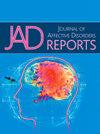血浆BDNF在倦怠相关抑郁症中的中介作用:感知社会隔离和多模式住院治疗的生物心理效应
Q3 Psychology
引用次数: 0
摘要
抑郁症的神经营养假说认为,BDNF表达的减少可能部分解释了抑郁症的发展,抗抑郁药增加BDNF水平和情绪。在这项研究中,我们旨在比较住院患者与健康对照者的血浆BDNF水平,并探讨多模式住院治疗的效果。此外,我们还研究了BDNF和感知社会隔离在预测抑郁严重程度中的中介作用。方法35例在某专业职业倦怠门诊就诊的住院患者和21例匹配的健康对照者参与本研究。住院患者在入院后(T1)和出院前(T2)分别填写了抑郁严重程度、倦怠、孤独感和社会隔离的自我报告问卷,以及医生填写的抑郁问卷(HAMD-17)。在同一时间点测定血浆BDNF浓度。住院患者在随访6个月(T3)时再次报告抑郁严重程度。在健康对照组中,心理数据和血液样本只采集一次。结果患者BDNF水平低于对照组(U = 267.00, p= 0.045)。治疗导致BDNF水平显著升高(z=-1.974, p= 0.024), BDNF水平的变化与抑郁严重程度呈负相关(HAMD-17: rs=0.30, p= 0.042)。最后,这种关联被感知到的社会孤立显著地介导。结论:研究结果支持神经营养假说和感知社会隔离的中介作用。临床相关的倦怠和抑郁的预防和治疗应分别将感知社会孤立和社会融合作为重要的危险因素和干预重点。本文章由计算机程序翻译,如有差异,请以英文原文为准。
Plasma BDNF in burnout-related depressive disorders: The mediating role of perceived social isolation and the biopsychological effect of a multimodal inpatient treatment
Background
The neurotrophic hypothesis of depression assumes that a reduced expression of BDNF may partially explain the development of depression, and that antidepressants increase BDNF levels and mood. In this study, we aimed at comparing plasma BDNF levels in inpatients with a burnout-related depressive disorder to those of healthy controls and explore the effects of a multimodal inpatient treatment. Moreover, we examined the mediating role of BDNF and perceived social isolation in predicting depression severity.
Methods
Thirty-five inpatients treated at a specialized burnout clinic and 21 matched healthy controls participated in this study. The inpatients responded to self-report questionnaires measuring depression severity, burnout, loneliness, and social isolation as well as a clinician-administered depression questionnaire (HAMD-17) after clinic admission (T1) and before clinic discharge (T2). Plasma BDNF concentrations were determined at the same time points. Inpatients reported on depression severity again at 6 months follow-up (T3). In healthy controls, psychological data and blood samples were collected only once.
Results
Inpatients exhibited lower BDNF levels than controls (U = 267.00, p=.045). The treatment led to a significant increase in BDNF levels (z=-1.974, p=.024), whereby the change in BDNF levels and in depression severity were inversely related (HAMD-17: rs=0.30, p=.042). Finally, this association was significantly mediated by perceived social isolation.
Conclusions
The findings support the assumptions within the neurotrophic hypothesis and a mediating role of perceived social isolation. Prevention and treatment of clinically relevant burnout and depression should consider perceived social isolation and social integration as an important risk factor and intervention focus, respectively.
求助全文
通过发布文献求助,成功后即可免费获取论文全文。
去求助
来源期刊

Journal of Affective Disorders Reports
Psychology-Clinical Psychology
CiteScore
3.80
自引率
0.00%
发文量
137
审稿时长
134 days
 求助内容:
求助内容: 应助结果提醒方式:
应助结果提醒方式:


